Japan’s Eco Busines: Saving the Earth and Saving Money
From Solar Panels to Spaghetti Noodles, the Color of Japanese Business Is GREEN
By Tom Baker
When you get behind the wheel of your car, turn up the air conditioner at home, or pop open a cold drink, are you destroying the environment? Many people worry about the impact of such activities, but most of them don’t want to give up their comfortable modern lifestyles. In response to such concerns, products claiming to be eco-friendly have become common, and some eco-products from Japan have been attracting attention around the world.
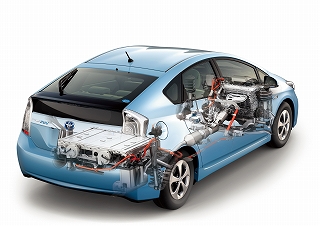
In Austin, Texas, for example, local resident Burleigh Custis said he is “very pleased” with his purchase of an eco-friendly Prius car. Toyota estimates that its latest Prius models, with their hybrid gas-electric power system, get 50 miles per gallon in the United States and better than 30 kilometers per liter in Japan, which means they use less gasoline and have lower greenhouse gas emissions than conventional automobiles. “The green aspect of the Prius heavily influenced my decision to buy it,” Custis said, adding that he now spends much less money on fuel than he used to and enjoys the satisfaction of “lending support to the alternative car movement.”
In a different part of the world, Myanmar opposition leader Aung San Suu Kyi has also taken notice of Japan’s green technology. She visited Panasonic Center Tokyo, a showroom in Tokyo where she looked at a model of an energy-efficient solar-powered house. According to a Panasonic spokesperson, she “asked many technical questions about systems using solar panels…She said that Japanese solar panels were expensive and she wanted Japanese makers to make solar panels that people can use on their homes in Myanmar.”
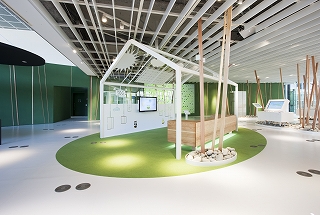
In Australia and Britain, restaurant chefs are getting on the green Japanese bandwagon too. According to Reina Otsuka, the founder and CEO of online eco-products store eco+waza, chefs appreciate the Naked Pan brand of cast iron pans that her company sells partly because they cook food well and partly because they are made with a centuries-old Japanese technique that renders them non-stick without the use of possibly harmful chemicals. That they are made with 75 percent recycled iron is another plus. There are reasons why so many eco-products are coming out of Japan.
A History of Eco-mindedness
One reason is that frugality is a deep-rooted Japanese virtue. Scholar and statesman Inazo Nitobe wrote in his 1900 book “Bushido, The Soul of Japan” that samurai (warriors) were expected to be thrifty and live in “severest simplicity.” Even today, “mottainai” – an expression roughly equivalent to “waste not, want not” – is commonly heard. Referring to the heirloom durability of Naked Pans, Otsuka said: “It’s mottainai to throw away my frying pan every five years. I can get this one and it will last for 100 years.”
A less traditional buzzword is “setsuden,” which means “saving electricity.” After the March 11, 2011, earthquake and tsunami led to meltdowns at the Fukushima No. 1 nuclear power plant, nearly all of Japan’s nuclear reactors are now idle. This led to short-term electricity shortages and what appear to be longer-term increases in power bills. Nearly everyone in Japan is eager to save electricity these days.
Less Electricity, Lower Impact
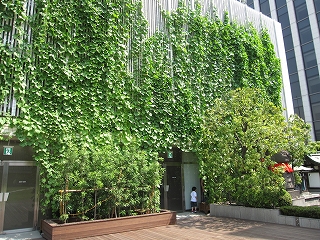
One result of the disaster was renewed in interest in “green curtains.” These are summer vines, used as natural screens to absorb sunlight that would otherwise beat down on the windows of homes or workplaces. Goya, a vegetable also known as bitter melon, is especially popular for this purpose. In his book, “Just Enough: Lessons in Living Green from Traditional Japan,” author Azby Brown writes that plants have been used this way for hundreds of years. Now they’ve made a comeback.
Other approaches to low-energy cooling are more high-tech. Zeffle, made by Japanese air conditioning company Daikin, is a layered chemical coating that can be painted onto roofs to insulate buildings from heat by reflecting near infrared rays, which account for half of sunlight. At the main Daikin product showroom in Shinjuku, Tokyo, two sections of identical-looking metal roofing are displayed side by side. One is treated with Zeffle, and the other is not. When a heat lamp is shined on them, the temperature under the untreated section rises much more quickly.
“After 3/11 a lot of companies did not use air conditioning because they could not use a lot of electricity. So there were a lot of companies buying this product at that time,” said Keiichiro Yanagida, manager of the facility.
Yanagida said that Daikin has begun using a refrigerant called R32 (also known as HFC32) in its air conditioners. This chemical has only one-third the global warming potential of the current most popular refrigerant, R410A. Also, it is so much more efficient at cooling that air conditioners using it require less electricity, which further contributes to the reduction of greenhouse gases. “Our company is the only company using this new refrigerant,” Yanagida said. When it comes to regulating temperatures at home, Japan has another natural advantage. “Just Enough” author Brown, who heads Kanazawa Institute of Technology’s KIT Future Design Institute in Tokyo, told, “Japanese don’t use what we [Americans] consider central heating. They don’t try to heat the whole house; they really confine it to the room that’s being used.” Heating or cooling a smaller space requires less energy.
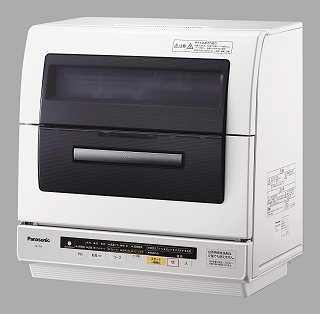
Panasonic is another company that has developed an array of eco-friendly home appliances, which it calls its Econavi line.
“After the earthquake, people’s awareness of energy saving and interest in energy-saving products increased. So energy-saving products have become more popular,” a Pansonic spokesperson said.
The company’s Econavi appliances keep an eye on their owners – almost literally – and adjust their functions accordingly. The Econavi air conditioner, for example, is equipped with a “human sensor” that detects the presence of people in the room by scanning for body heat. It then directs the flow of air to where the people are, and adjusts its functions depending on the detected level of activity. It claims to reduce electricity use by up to 30 percent.
Similarly, the Econavi refrigerator can learn its owners’ habits by keeping track of the times of day when the door is most likely to be opened, and sensing whether the kitchen lights are on or off. It can record up to three weeks of activity, learning to go into energy-saving mode during the quieter times of day or night while powering up when it is likely to be busy. In doing so, it claims to reduce energy use by up to 40 percent.
Dishwashers are appliances that, like air conditioners, sometimes come in a compact Japanese variety. “In the past, Japanese kitchens were not large, and system kitchens [with built-in appliances] were not common, so smaller non-built-in products like the table-top dishwashers became popular,” the Panasonic spokesperson said. One new model of Econavi dishwasher, which looks like small cabinet sitting on a kitchen counter or mounted above a sink, includes a variety of “thinking” features. A dirt sensor “detects the dirtiness of the water by the level of cloudiness, and controls the washing time, temperature and rinses.” A bubble sensor adjusts the amount of water used to wash away suds in the rinse cycle. Yet another sensor detects how many dishes have been loaded. The data from all of these sensors is used to achieve the most efficient control over machine’s use of energy and water.
Feeling Good with Less Water

Moving from the kitchen to the bathroom, another Japanese company, TOTO, boasts of its water-saving plumbing fixtures. Toilets with the company’s Tornado Flush feature are designed so that jets of water swirl more powerfully around the bowl than in conventionally designed toilets, reducing the amount of water per flush from 13 liters to 3.8 liters.
The company’s Air-In showerhead (marketed globally as Aerial Shower technology) has tiny holes in its back to draw in air as the water rushes through. The interior of the showerhead is designed to mix the air and water in such a way that large water droplets contain small bubbles of air. When they strike your skin, the droplets supposedly feel the same as “solid” droplets, even though the Air-In uses only 6.5 liters of water per minute, compared with the 10 liters that a conventional showerhead might use.
To win over anyone who might feel skeptical of that claim, Toto set up two operating showerheads side by side at an eco-products trade show in Tokyo in December, so visitors could stick their hands in to feel the water pressure for themselves. Your reporter gave it a try. I felt no difference, even though the Air-In filled up the clear tank below its drain much more slowly than the ordinary showerhead.
Spokesperson Ayako Uchiyama said this was a key point in Toto’s efforts to appeal to consumers. People can save water while showering for just as long as they always have, and without reducing the water pressure. Because they can feel good about putting less strain on the environment even without altering their behavior, she said such products are “ecologically friendly and user-friendly.”
“Downcycling” Wood
Water is not the only resource that Japanese engineers are trying to conserve. Another is wood. In “Just Enough,” Brown describes the old-fashioned Japanese attitude toward the thrifty and ecological use of wooden objects: “a broken plow frame can become an axe handle, a broken axe handle refitted to a scoop, a broken scoop added to the firewood pile (and its ashes finding their way to the fields again as fertilizer).”
You might call that recycling, but the word “downcycling” also applies, since each object in the chain is less valuable than the one before. Even so, the process meant getting maximum use out of one piece of wood.
In modern times, the lifecycle of a piece of wood can be much shorter: It might go from tree to furniture to the junkyard – or the incinerator.
According to Momoyo Matsuyama, a science communicator at the National Museum of Emerging Science and Innovation (Mirakan) in Tokyo, efforts are under way to expand the downcycle uses of discarded wood. In nature, she said, trees absorb carbon dioxide and assemble it into more complex polymer molecules. After the long life of the tree, the wood gradually degrades over a long time, slowly releasing carbon dioxide again.
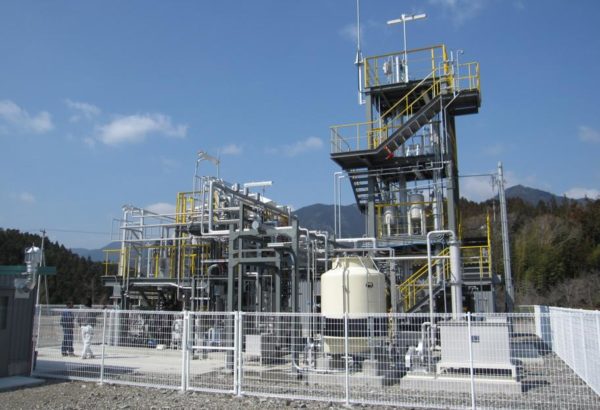
Matsuyama described the work of Prof. Masamitsu Funaoka of Mie University to “learn from nature” by getting as much use as possible from wood before ultimately releasing its CO2. As background, she explained that wood cells are “mainly made from cellulose, hemicellulose and lignin.” The first two substances can be used to make ethanol, she said, so Funaoka focused on lignin, which generally goes to waste.
Isolating lignin from wood is difficult, as heat and pressure tend to change the lignin in undesirable ways. “It is almost impossible to effectively utilize highly modified lignin derivatives as functional material,” Funaoka explained.
“I developed a novel technology for converting native lignins to functionality controllable lignin-based phenolic polymers (Lignophenols)…without any heating and pressing,” he said. At a pilot plant that Funaoka built in Tokushima Prefecture last year, he converts lignin into lignophenols that he uses, together with cellulose, to create a woodlike composite material that can be formed into useful objects ranging from coffee mugs to auto body panels – some of the same purposes that oil-based plastics can be used for now.
As the lignin’s polymer chains break down and grow shorter, its uses become more limited – just as with that old-fashioned plow frame. Near the bottom of the downcycling cascade, the lignin is no longer much good for solid objects, but it can still be used to make electricity-generating pigments for solar panels. Ultimately, the material ends up discarded and likely burned, but in the meanwhile, for the same amount of CO2 emissions, people can put the same material to use over and over again to achieve a variety of functions.
“Saving the Earth and Saving Money” Is a Key
“If you want to use the word ‘eco-market,’ I’m pretty sure that it has been getting bigger,” Otsuka said. “And it’s not only about the environment; people are really aware of it having a social aspect as well. It has to be an ethical product. ‘Ethical’ and ‘eco’ are really hand-in-hand concepts.”
After the 2011 disaster, she often heard people use the expression “ikasarete iru” to describe their realization that “we’re just growing on top of nature…Nature is there and it’s being tolerant of humans so we can live. It’s not like we are dominant and we can do whatever with nature. So people changed their mind-set after the earthquake, for sure.”
For those people, the appeal of eco-products is clear. Living in harmony with nature is laudable and feels good. But there are also many people who would rather save money than save the planet. Even for them, eco-products are often an attractive choice.
Brown said: “My impression, and it’s constantly reinforced, is that manufacturers across the board are shaving energy use off of everything that they’re making. And that’s driven primarily by the market, and the market is driven not by ecological concerns but by wanting to save on energy costs.”
If a product costs more or doesn’t work as well or is less convenient to use, it is not likely to be a commercial success no matter how eco-friendly it may be. To compete, green products should function at least as well as non-green ones—a point that TOTO’s side-by-side showerhead demonstration was meant to illustrate.
To really succeed in the marketplace, an eco-product should give consumers tangible benefits beyond the pleasure of feeling ecologically virtuous. In some cases, saving money through more efficient use of resources is a big green advantage.
Idea of Eco-consumption
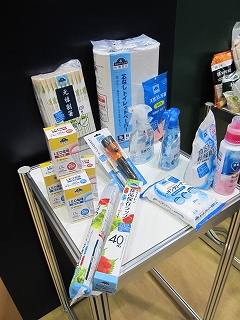
Some green products, especially in the food and beverage field, save money by reducing the amount of packaging they use. For example, the Aeon supermarket chain offers thrift-minded Japanese consumers toilet paper with no cardboard tube in the middle of the roll, which leaves nothing to be discarded when the product is used up. It’s cheaper to produce, and it happens to be good for the environment, too.
Similarly, Aeon has some low-priced instant ramen that saves material and money by coming with spice powder already on the noodles, which is more efficient in terms of packaging than the usual practice of having the flavorings in separate foil or plastic sachets. The Nisshin Seifun Group has shown that even noodles themselves can be made eco-friendly. Among the offerings in its Mama pasta line is a kind called Super Pront. If you were to pick up a normal spaghetti noodle and look at its end, you would notice that it has a round cross-section. But a Super Pront spaghetti noodle has a cross-section shaped like a motorboat propeller. When the pasta is cooking, this allows boiling water to penetrate to the center of the noodle more quickly, which reduces cooking time. This makes the product more convenient, and it also means less gas or electricity is consumed, which enables Nisshin Seifun to market the noodles as eco-friendly. You could try such noodles with tomato sauce or cream sauce, but I would suggest pesto. After all, it’s green.
Insert Coin, Save Energy
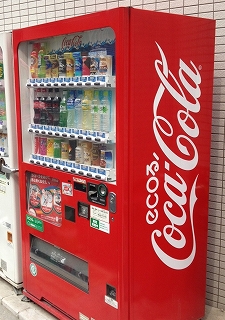
One thing visitors to Japan notice almost immediately is the ubiquity of vending machines. According to Takashi Kurosaki, director-general of the Japan Vending Machine Manufacturers Association, there are about 5.1 million vending machines in the country – one for every 25 people. About 2.56 million of the machines sell drinks. About 300,000 new vending machines are shipped every year, mostly to replace older ones.
Some people, including former Tokyo Gov. Shintaro Ishihara, have criticized vending machines as a waste of electricity.
But Kurosaki says that his industry has made great strides in energy saving over the years. For example, a drink vending machine is basically a metal cabinet full of cans. It resembles a big refrigerator. Twenty years ago, all of these cans were kept cold. But all vending machines in use today use “zone cooling” to chill only the four or five cans nearest the bottom, which are the soonest to be sold.
Another innovation is the use of heat pumps for heating and cooling hot and cold drinks. Ten years ago, Kurosaki says, the machines didn’t use the warm air created as a byproduct of the cooling process. But now this feature is found in about 85 percent of new machines selling canned drinks.
Yet another eco-measure is electronic sensors that turn the machines’ lights on and off depending on whether or not it is dark out. It is also now standard for the machines to turn off their own cooling functions for at least three hours on summer afternoons, from July through September. Kurosaki stressed that all machines have been manufactured with this function since 1998, well before the intense interest in “setsuden” electricity conservation measures that followed the March 11, 2011, Great East Japan Earthquake and tsunami.
In 1991, average annual electricity use per machine was about 3,500 kilowatt-hour per year, but Kurosaki says his organization estimates the figure for 2012 will come in at around 950 kilowatt-hours per year. So next time you’re feeling thirsty in Japan, go over to one of those brightly colored machines and buy a drink with a clear conscience.

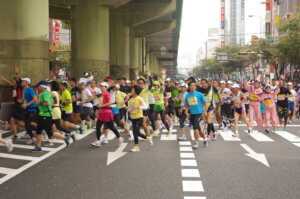
自宅内の工房には、制作・調律中の尺八や工具が所狭しと並ぶ-300x225.jpg)